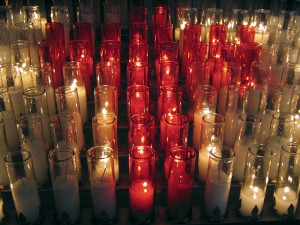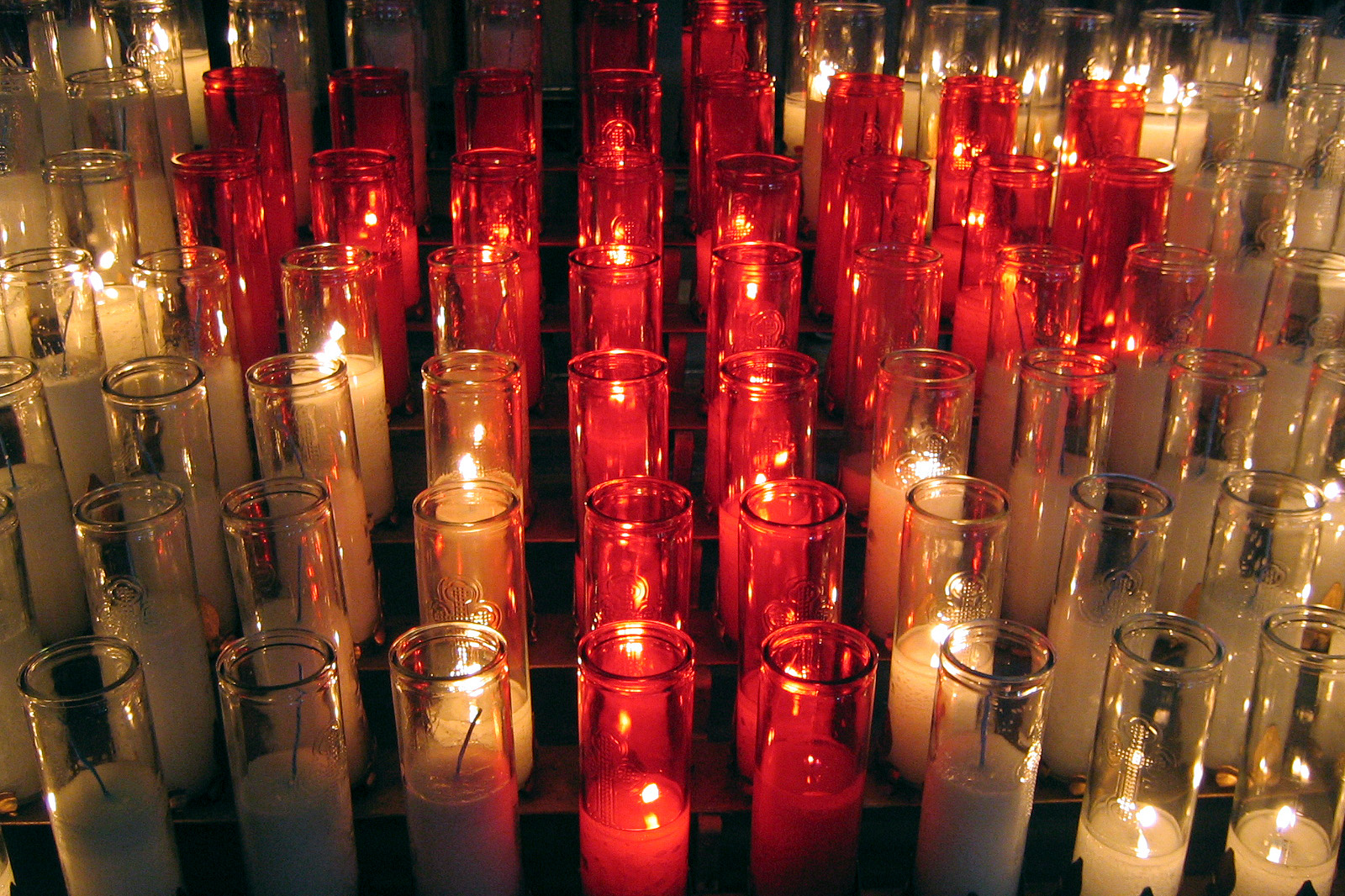 When I was younger and through my seminary years I had usually seen the crucifix and Jesus’ suffering on the cross in somber tones. It was my sin that put him there, had made him suffer. The cross was something that compelled a silent reverence, and suggested to me that I meditate deeply on what Jesus had to go through. Perhaps too I would think of Mary and John and the other women mournfully beneath the cross beholding Jesus slowly and painfully dying. These were heavy and somber notes, but deeply moving themes.
When I was younger and through my seminary years I had usually seen the crucifix and Jesus’ suffering on the cross in somber tones. It was my sin that put him there, had made him suffer. The cross was something that compelled a silent reverence, and suggested to me that I meditate deeply on what Jesus had to go through. Perhaps too I would think of Mary and John and the other women mournfully beneath the cross beholding Jesus slowly and painfully dying. These were heavy and somber notes, but deeply moving themes.
In addition the crucifix also called forth memories that I must carry a cross and go through the Fridays of my life. I needed to learn the meaning of sacrifice.
Liturgically I also saw the crucifix as a way of restoring greater reverence in the Mass. Through the 70s and 80s parishes had largely removed crucifixes and replaced them, quite often, with “resurrection crosses,” or just an image of Jesus floating in mid air. I used to call this image “touchdown Jesus” since he floated in front of the cross with his arms up in the air as if indicating a touchdown had just been made. In those years we had moved away from the understanding of the Mass as a sacrifice and were more into “meal theology.” The removal of the crucifix from the sanctuary was powerfully indicative of this shift. Many priests and liturgists saw the cross as too “somber” a theme for their vision of a new and more welcoming Church, upbeat and positive.
A cross-less Christianity tended to give way to what I thought was a rather silly celebratory style of masses in those years and I came to see the restoration of the Crucifix as a necessary remedy to restore proper balance. I was delighted when, through the mid 80s and later, the Vatican began insisting in new liturgical norms that a crucifix (not just a cross) be prominent in the sanctuary and visible to all. Further, that the processional cross had to bear the image of the crucified, not just be a bare cross.
Balance Restored – I was very happy about these new norms (and still am) because they restore the proper balance in seeing the Mass as a making present of the once-for-all perfect sacrifice of Jesus on the cross. It is also a sacred meal, but it is the sacrifice that gives it its power. I further thought that such a move would help restore greater and proper solemnity to the Mass, and to some extent this has been true.
All of this background just to say that I saw the Cross, the crucifix, in somber, serious tones, a theme that was meant to instill solemnity and sobriety, a meditation on the awful reality of sin and our need to repent. And all of this is fine and true.
But the Lord wasn’t finished with me yet and wanted me to see another understanding of the Cross. He wanted to balance my balance!
In effect he wanted me to experience also the “good” in Good Friday. For while the cross is all the things said above, it is also a place of victory and love, of God’s faithfulness and our deliverance. There’s a lot to celebrate at the foot of the cross.
It happened one Sunday in Lent of 1994, one of my first in an African American Catholic Parish. It being Lent, I expected the highly celebratory quality of Mass to be scaled back a bit. But, much to my surprise, the opening song began with an upbeat, toe-tapping gospel riff. At first I frowned. But the choir began to sing:
Down at the cross where my Savior died,
Down where for cleansing from sin I cried,
There to my heart was the blood applied;
Glory to His name!
Ah, so this WAS a Lenten theme! But how unusual for me to hear of the cross being sung of so joyfully. (You can hear the song in the video below; try not to tap your toe too much).
It was something quite new for me. Perhaps it shouldn’t have been but it was. The 70s and 80s Catholicism that had been my experience found it necessary to remove the cross to celebrate. But here was celebration with and in the cross! Here was the good in Good Friday.
The Choir continued:
I am so wondrously saved from sin,
Jesus so sweetly abides within;
There at the cross where He took me in;
Glory to His name!
Congregation and choir were stepping in time and clapping, rejoicing in the cross, seeing it in the resurrection light of its saving power and as a glorious reflection of God’s love for us. Up the aisle the procession wound and the last verse was transposed a half step up, an even brighter key:
Oh, precious fountain that saves from sin,
I am so glad I have entered in;
There Jesus saves me and keeps me clean;
Glory to His name!
Yes, indeed, glory to his name! A lot of dots were connected for me that day. The cross indeed was a place of great pain, but also of great love, there was grief, but there was also glory, there was suffering, but there was victory.
Please do not misunderstand my point. There IS a place and time for quiet, somber reflection at the foot of the cross. All the things said above are true. But one of the glories of the human person is that we can have more than one feeling at a time. We can even have opposite feelings going on at almost the same moment!
The Balance – Some in the Church of the 70s and rejected the cross as too somber a theme, too negative. They wanted to be more upbeat, less focused on sin, and so, out went the cross. There was no need to do this and it was unbalanced. For at the cross, the vertical, upward pillar of man’s pride and sin is transected by the horizontal and outstretched arms of God’s love. With strong hand, and outstretched arms the Lord has won the victory for us: there at the cross where he took me in, glory to his name!
And the Balance is for the individual, and for the Church. For some prefer a more somber meditation on the cross to prevail and others feel moved by the Spirit to joyfully celebrate at the foot of the Cross. The Church needs both, and I suppose we all need some of both experiences . Yes, it right to weep at the cross, to behold the awful reality of sin, to remember Christ’s sacrifice. But rejoice too, for the Lord has won victory for us, right there: Down at the Cross. There’s a lot of good in Good Friday.
Here is the song I heard that Sunday in 1994, sung in very much the style I heard.


I think it is safe to say that worship is a cultural expression of ones upbringing as well as the emotional release by the design of one’s preference. The Lenten season and the sacrifice of the mass in my view are something different of historical and spiritual significance to be contemplated with meditation that brings us to an understanding of mankind’s place in God’s divine plan. I can enjoy all styles of music but they take us in different emotional directions and to some may be distracting. Scripture and the sacrifice of the mass are self-evident. When you start scoring it, you play on peoples emotions and that can conflict culturally with ones personal preferences like an annoying song you can’t get out of your head. Symbolisms can be archetypical or cultural. Realism is the best symbolism because it’s what God has revealed. Touchdown Jesus is art like music and takes us in different emotional directions. That’s fine but it’s not necessarily reality.
Echoes, reflections and reverberations. I read this post early this morning. What a kick when afterwards I turned on EWTN and caught Pope Francis’ first papal audience. His remarks reminded me of past ’99 and a Half Won’t Do’ blog posts found here and today’s post about not only sorrow but victory and love beneath the Cross.
“We are called to follow in his footsteps. Holy Week challenges us to step outside ourselves so as to attend to the needs of others: those who long for a sympathetic ear, those in need of comfort or help. We should not simply remain in our own secure world, that of the ninety-nine sheep who never strayed from the fold, but we should go out, with Christ, in search of the one lost sheep, however far it may have wandered. Holy Week is not so much a time of sorrow, but rather a time to enter into Christ’s way of thinking and acting. It is a time of grace given us by the Lord so that we can move beyond a dull or mechanical way of living our faith, and instead open the doors of our hearts, our lives, our parishes, our movements or associations, going out in search of others so as to bring them the light and the joy of our faith in Christ.” Excerpt, Pope Francis 3/27 Papal Audience.
One good thing is just about every parish returned the crucifix to its place. If there is going to be a new Springtime (Could it be put in words what that would look like?), then putting the crucifixes back was a necessary precursor.
One might feel sorry for Jesus, that He suffered and died for each of us. But that is a concept based on what one human may feel for another human, who has sacrificed for him. To think this of Jesus would imply that He should have created the universe in a different form, in which HIs death on the cross was unnecessary, that He did not freely choose to suffer and die without regret. For me the correct way to view Jesus on the cross is heartfelt gratitude. Not only did He die for my soul’s sanctification, but He was the prime example of “No greater love”.
i meditate and pray at the cross throughout each day. Lately in my meditation has come the vision of Christ on the Cross and just for a brief moment i see hidden joy in His eyes and feel His victory run through me. And i am so very thankful God loves us this much.
The perfect sacrifice. . .for us.
The Resurrection clarifies all.
All good meditations to hold us close to Him.
The Pope emphasizes the Cross in all our works.
Thank you Monsignor.